Book: Health and Fitness

Do you want to know is kayaking safe for non swimmers? Are looking for suggestions to practice kayaking, being a non swimmer? Today we will talk about Kayaking along with the safety guide. You can have a great time practicing kayaking with your friends and family, also with children. Because it is a really fun and exciting sport.
Even if you don’t know how to swim, you can have fun! You could have a great time, although it is highly recommended especially if you are going to go for less calm, more hectic routes.
Kayaking is a relatively safe sport, but everyone involved should be prepared for uncertain risks. Safety techniques are easy to learn, and we strongly recommend mastering them before officially participating in kayaking activities.
You Can Kayak if You Don’t Know How to Swim. Yes, it is not essential to know how to swim to row a kayak. Under the guidance of professional coaches, you can learn in ten minutes! Much faster than learning to swim; because kayaking is different.
It can get close to the water, but it has an extra layer of floating protection for small boats. Stir the oars, and the slender hull sweeps over the water. Two waves extend melodiously from the stern. See the lakes and mountains in the open water, the direction is in your own hands.
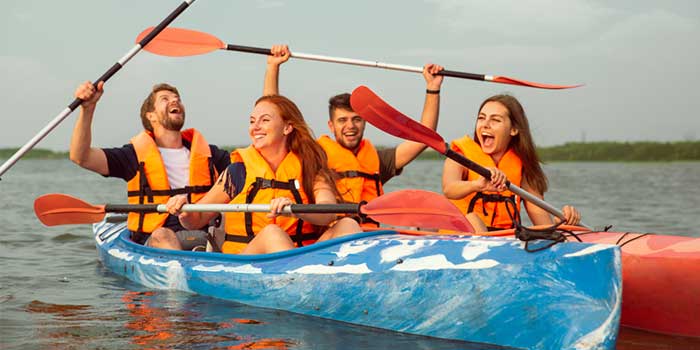
You can participate if you don’t know how to swim. Just follow the Safety rules for kayaking and wear a life jacket. Don’t be afraid of the ship capsizes, put on a life jacket, relax your body, look up at the sky, and get back to the ship with the assistance of your team leader or companion.
But learning to swim at least a little will give you much more confidence and security. So, the best thing is that you try to learn to swim little by little to feel more secure and confident when you go rowing.
Therefore, we bring you some safety rules for kayaking to be more confident in this activity. Keep reading and get to know them.
The first thing to mention is that you should be aware of the weather conditions and the water temperature. It is essential to be prepared for changes in the weather and the possibility of a rollover.
For example, outside it may not be so cold, but the water is freezing, so you should dress thinking about what will happen if you fall into the water.
If you’re paddling in cold water, the right suit can make a difference; you should have one to keep you warm and comfortable.
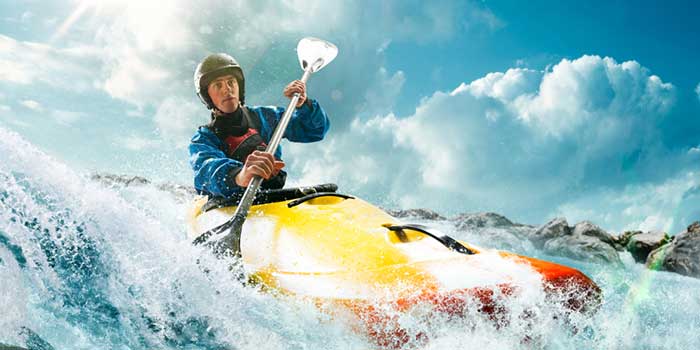
On the other hand, if it is hot, a long-sleeved shirt will help protect you from the sun, as well as the correct use of sunscreen.
Investing in the appropriate clothing for the weather conditions of your kayak tour will be key to your comfort and safety.
One advantage of indoor seated kayaks is that it protects you from the elements as long as you don’t turn around.
Remember to always dress according to the day. Check the weather conditions before going on your tour. Do not forget the wind, the breeze from the high seas could complicate the return to the coast.
It is better to be well informed before going out on the water and to know the route you will do by kayak.
Being in the sea, a lagoon, or lake, in any type of kayak it is essential that you follow certain rules for greater safety. There are always chances of injuries or minor accidents, so common sense and following rules are essential.
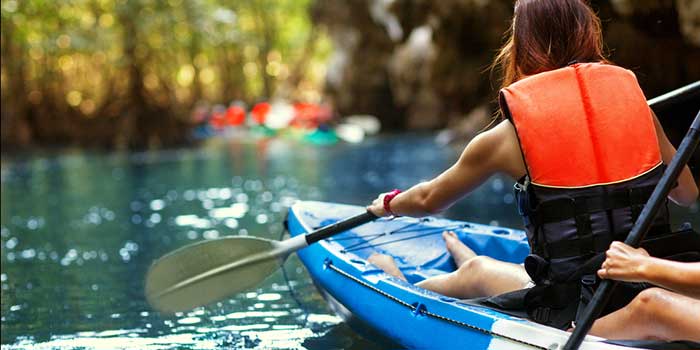
1. Follow the conditions for navigation in the area you are in. Do not infringe upon them if there are forbidden regions.
2. Always examine the equipment you’ll be using and don’t exceed the boat’s weight capacity. Double-check the condition of equipment such as life jackets and shovels.
3. Look for quality instructors, or follow kayak guides, which will give you an introduction to the practice, rowing techniques, and safety in the water.
4. Always use your personal flotation device or life jacket. The regulations indicate that everyone in a kayak must use it, having it will help you stay above the water and will add insulation to your body if the water temperature is very cold. There are specific vests for kayaking, if you do it regularly buy yours.
5. If you are not going with a group excursion, but decide to kayak independently, tell someone your navigation plan. Give them details about where you are going, what you will do, how long you expect the activity to take you, and if you will be accompanied. Follow the plan and notify when you have returned.
6. If you paddle in areas like rivers or near rocks, wear a helmet to protect yourself.
7. Stay hydrated and bring food if you will be away for long hours. When rowing you will lose calories and energy, it is best to replace them, energy bars and fruits are excellent for this.
8. If you are going to kayak in a new area, which you have not been to before, talk to others who have already traveled it. Ask about coastal conditions, wave patterns, weather, etc. Create an escape plan and route in case something changes in environmental conditions.
Now we are going to mention the basic safety measures in the kayak and the equipment you will need.
In addition, you should check the conditions of the kayak and accessories. That everything is in perfect condition for a safe and pleasant trip. If you go in a group, everyone must know the safety regulations.
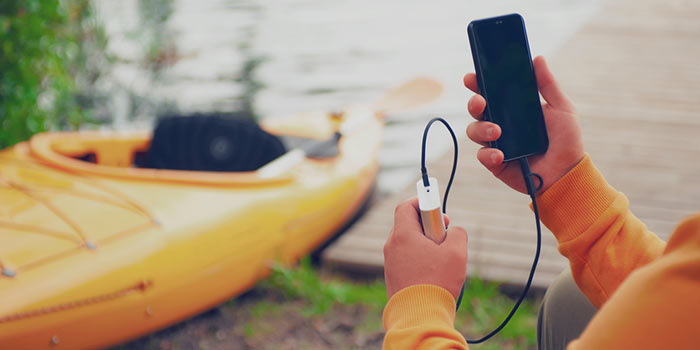
No matter what type of boat you are in, make sure you always wear a life jacket. Not all personal flotation devices are the same. It will depend on your size, type of boat, conditions, among other details.
You can go for PFD. PFD stands for Personal Floatation Device, which is basically a life jacket or life jacket for a kayak.
You can choose PFD from Amazon by clicking here.
Friends who have played at the beach know that the sound of wind and waves are mixed, and the decibels are very high. If you are a little far away, you can’t hear each other.
Once you fall into the water, ask for help. The lifeguard whistle can help you, the decibel is high, the spread is far, and it saves effort. When buying, it is best to buy a whistle that can be blown underwater.
We already mentioned what you can do after a fall, you can climb alone or with the help of another. A paddle float will be your best support for a solo rescue. Attached to the paddle blade of the kayak, helps stabilize the kayak for re-entry.
The person places the float on the blade, first inflates it if it is of this type. Then, slide the other blade under the ropes of the kayak, and use the paddle as a support to get on deck.
The float for the shovel is another device that will be very helpful. Some are inflatable or made of foam and slide on the tip of the paddle. Once placed there it will float, which will help make it easier to get back into the boat.
The paddle float will be a necessary item for your walk.
The seawater is corrosive and the waves are large. It is easy for beginners to overturn the boat, so a good quality waterproof rucksack is a must. Store food, clothing, communication equipment, etc.
Sprayskirts help keep moisture in the kayak. They are essential for white water and sea kayaking. Recreational kayaks can be done without them. You have to make sure that the skirt fits you and the kayak.
If you go in a kayak group someone should bring the first aid kit. There are some specific ones for this practice, but you can take one that you put together at home, with the essential content to deal with emergencies.
Remember that medical emergencies require quick responses, so you don’t want to have to search far to find the kit and what you will require.
Helmets are essential for navigation in fresh water, such as rivers, lakes, or lagoons. Because they are spaces with rockier areas. The helmet should fit well, not tight, comfortable, and have a safety strap that fits across the chin.
If you decide to go kayaking alone, it is best to bring an extra paddle, in case you fall or the first one sinks and you lose it.
You can also have dry, waterproof bags that close and float. You can have your mobile, extra clothes, a map, among other security elements such as a radio.
Communication equipment such as radios or smartphones will be helpful. They will help you stay informed about the weather conditions. In addition, with these, you can communicate in case of emergency.
Signaling devices are used to attract the attention of individuals who are far away for simple voice communication. They are teams that will capture the attention of people who can help you in an emergency.
You can check other useful equipment for kayaking from Amazon by clicking here.
The following is a list of safety aspects so that you can avoid the danger of being a non-swimmer.
1. Avoid rowing alone
2. Don’t forget, the weather is often transient
3. Avoid rowing far from the coast
4. Carry a map with rocks and sea marks
5. Avoid rowing near the route
6. If it’s dark, use headlights.
If you have never kayaked and are starting to discover this fabulous water sport, we want to talk to you about some healthy habits to then row better.
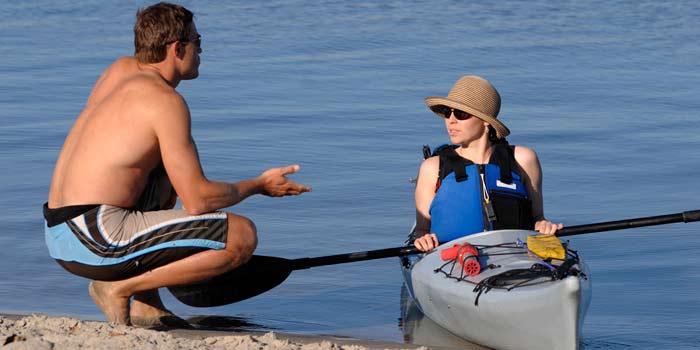
We always recommend taking a small class at the beginning, especially if you are not used to it. But anyone who leads a healthy life and plays sports from time to time will be able to kayak without fatigue. Although this will not be easy at first!
But one of the keys to kayaking and paddling better is to take a few classes at the beginning (a couple of hours is enough). On the Internet, you will find many tutorials for you to learn to row. It can also come out of you since there are many people that nobody has taught them and they can row to get out of trouble. But you must follow certain techniques so as not to get tired or hurt yourself.
The fact of rowing badly makes you hurt or tire yourself more than necessary. That is why you must take classes or read a lot about how to row correctly and maintain the correct body position to achieve it. In addition, it also depends on the environment in which you find yourself, it is not the same to paddle with your sea kayak as to do it in a lake without any type of current.
It helps a lot to be in shape and practice other similar sports such as canoeing. This will help you to be able to kayak without fatigue and successfully. Since if you practice other similar sports, you will already have a strong base below help.
Being in shape is crucial in these rowing sports, so you don’t get tired and enjoy yourself. If you want to really enjoy kayaking, you will need to be in a minimum of physical shape. When you practice it, you will notice it yourself. Although sometimes, you get more tired if you are doing it “wrong.” That is why it is important that you read some tricks to learn to row or that you start from less to more.
By following good healthy rowing habits, you will be able to enjoy kayaking as you deserve. So if you dare to buy a kayak, you should practice your rowing technique to enjoy it to the fullest.
Falling out of the kayak is something that can happen to novices and experts. There are different ways to get back on, there is an option that according to experts is the easiest for open kayaks.
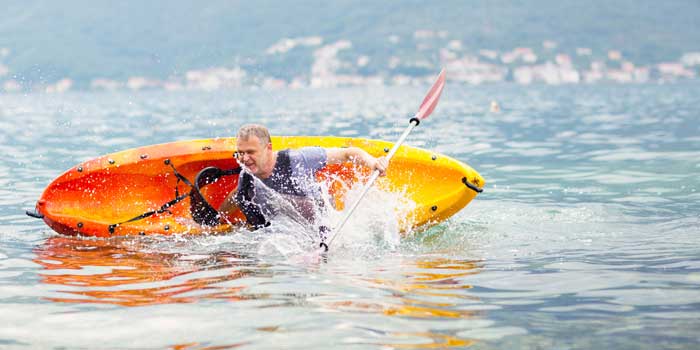
1. If the kayak is flipped you will need to rotate it. To do this, try to reach the bottom, grab the scupper holes. Bring your knees up to this part, lean back, and the boat will flip.
2. Next, get into a position where your head is close to the seating area of the boat, facing the kayak. Try to float in the water, push yourself with your feet until your belly button is almost out of the water.
3. Reach the furthest part of the boat, then push yourself in, so that your belly button is in the center of the boat, specifically the cockpit.
4. Turn towards your rear so that you end up on the seat, in the correct position. Sit back, swing your feet, and voila. You can start over.
If you are in a group, you will receive help and it will be much easier to get back to your boat. But, it is best to know this technique well to avoid giving in to panic.
We feel that not being able to swim should not restrain you from enjoying the benefits of kayaking. You only need to be aware of the appropriate strategies and tools to help you feel at ease and be safe while on the water.
By following these safety rules to practice kayaking you will have a safer and more fun adventure. There are many addicts to kayaking and this number is increasing every time because it is “another world”. You will be able to enjoy the seabed, while you do sports, relax and disconnect.
© 2022 The World Book. All Rights reserved.
Founder: Nayma Nishat